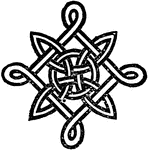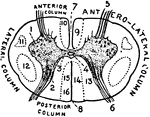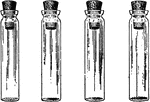Clipart tagged: ‘cord’

Air Passage
"To illustrate roughly the passage of air through the glottis, force air through such a tube by blowing…
Muscles of the Arm
"Muscles on the front of the arm. Note the while cords, the tendons at the wrist." —Davison, 1910
Gravitational Attraction
"Two cannon balls, when suspened by long cords, so as to hang quite near each other, are found to exert…
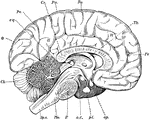
Brain
"Diagram of the left half of a vertical median section of the brain. H, H, convoluted inner surface…

Central Nervous System
"Brain and spinal cord, with the thirty-one pairs of spinal nerves." — Tracy, 1888
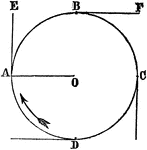
Centrifugal Force
"Attach a ball, for instance, to a cord; and , fastening the end of the cord at a point, O, give a quick…

Dissected Fish
"Dissected fish. a, air bladder; b, urinary bladder; b, urinary bladder; br, brain; c, spinal cord;…

Dissected Frog
"Frog with the left side cut away and some of the organs pulled downward. a, aorta leading from the…

Knots and Splices
"Knots and splices include all the various methods of tying, fastening, and joining ropes or cords.…
Knots and Splices
"Knots and splices include all the various methods of tying, fastening, and joining ropes or cords.…
Knots and Splices
"Knots and splices include all the various methods of tying, fastening, and joining ropes or cords.…
Knots and Splices
"Knots and splices include all the various methods of tying, fastening, and joining ropes or cords.…

Knots and Splices
"Knots and splices include all the various methods of tying, fastening, and joining ropes or cords.…

Knots and Splices
"Knots and splices include all the various methods of tying, fastening, and joining ropes or cords.…
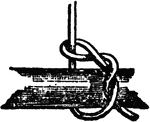
Knots and Splices
"Knots and splices include all the various methods of tying, fastening, and joining ropes or cords.…
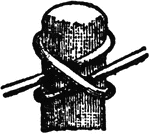
Knots and Splices
"Knots and splices include all the various methods of tying, fastening, and joining ropes or cords.…

Knots and Splices
"Knots and splices include all the various methods of tying, fastening, and joining ropes or cords.…
Knots and Splices
"Knots and splices include all the various methods of tying, fastening, and joining ropes or cords.…
Knots and Splices
"Knots and splices include all the various methods of tying, fastening, and joining ropes or cords.…
Knots and Splices
"Knots and splices include all the various methods of tying, fastening, and joining ropes or cords.…

Knots and Splices
"Knots and splices include all the various methods of tying, fastening, and joining ropes or cords.…
Knots and Splices
"Knots and splices include all the various methods of tying, fastening, and joining ropes or cords.…
Knots and Splices
"Knots and splices include all the various methods of tying, fastening, and joining ropes or cords.…

Knots and Splices
"Knots and splices include all the various methods of tying, fastening, and joining ropes or cords.…

Knots and Splices
"Knots and splices include all the various methods of tying, fastening, and joining ropes or cords.…

Knots and Splices
"Knots and splices include all the various methods of tying, fastening, and joining ropes or cords.…

Knots and Splices
"Knots and splices include all the various methods of tying, fastening, and joining ropes or cords.…

Knots and Splices
"Knots and splices include all the various methods of tying, fastening, and joining ropes or cords.…
Medulla Oblongata
"The spinal cord and medulla oblongata. A, from the ventral, and B, from the dorsal aspect; C to H,…

Movable Pulley
"A movable pulley is one whos block is movable. One end of the cord is fastened to the beam, and the…

Nerve Roots
"The spinal cord and nerve-roots. A, a small portion of the cord seen from the ventral side; B, the…
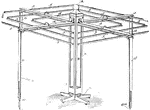
Clothes Rack
A drying rack is a device intended for hanging clothing to dry. Usually constructed from wood or metal,…

Section of Spinal Cord
"Diagram of a slice across the spinal cord, showing the roots of a spinal nerve to the arm on the left.…
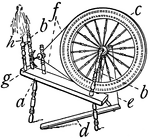
Spinning Wheel for Flax
"A machine for spinning flax into threads by hand. It consists of a wheel, band, and spindle, and is…
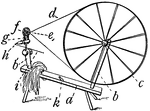
Spinning Wheel for Wool
"A machine for spinning flax into threads by hand. It consists of a wheel, band, and spindle, and is…
Leather Tassel
This leather tassel is a German Renaissance design found on a lady's bag. It is a simple knot to keep…
Modern Tassel
The modern tassel consists of a tuft of threads or cords hanging straight down from a core of wood,…
Modern Tassel
The modern tassel consists of a tuft of threads or cords hanging straight down from a core of wood,…
Modern Tassel
The modern tassel consists of a tuft of threads or cords hanging straight down from a core of wood,…
Modern Tassel
The modern tassel consists of a tuft of threads or cords hanging straight down from a core of wood,…
Old Standard Tassel
The old standard tassel consists of a tuft of threads or cords hanging straight down from a core of…
Tunisian Pistol Tassel
The Tunisian pistol tassel is a cord with a simple knot to keep the cord from ravelling-out.

French Lady's Girdle Tassels
The French lady's girdle tassels is a12th century design. This shows the tassels of a girdle that terminate…

Musical Violin
The treble instrument of the family of modern bowed instruments, held nearly horizontal by the player's…


